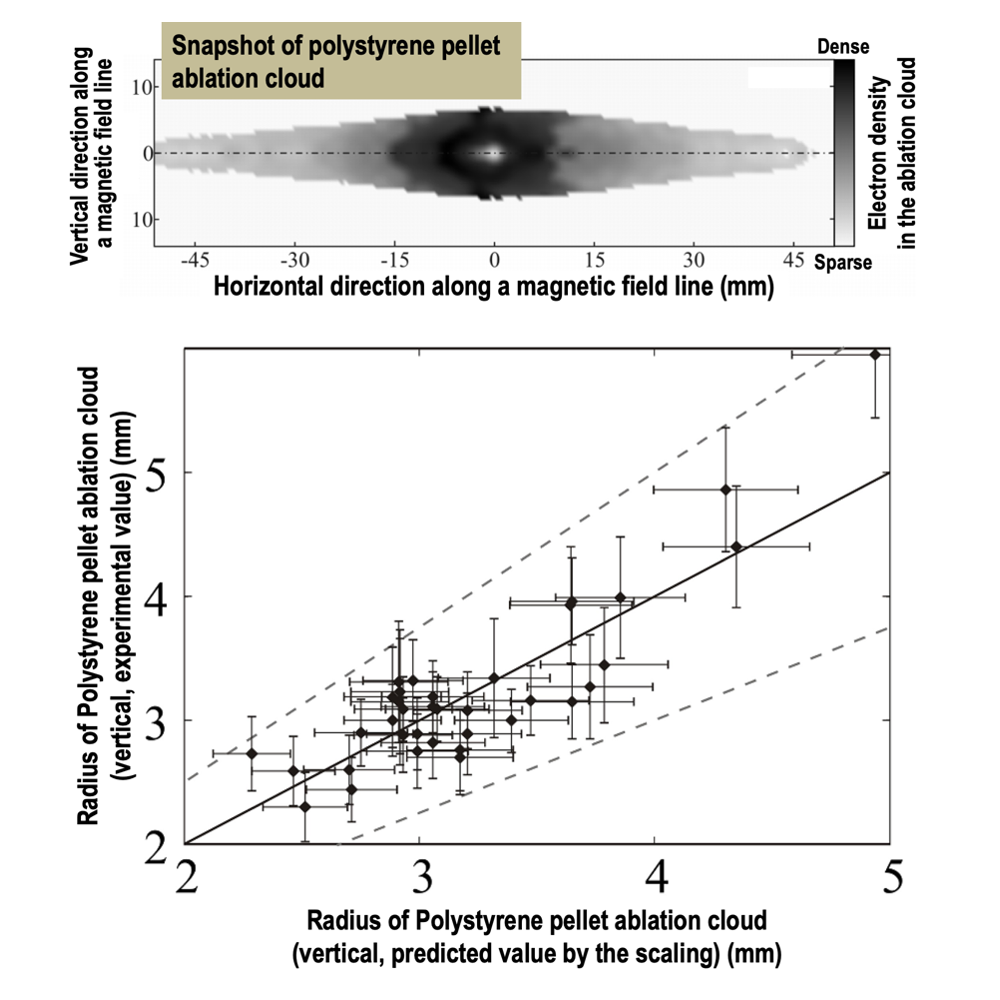Advances in the understanding of pellet injection as a plasma diagnostic technique
Layers of neutral gas and ions are formed around a hydrocarbon pellet injected into a high-temperature plasma due to interaction with the high-temperature plasma. In this study, we succeeded in deriving a scaling law that determines the region where the light emitted from the pellet is observed. This result enables us to predict the spatial distribution of the electron density and electron temperature around hydrocarbon pellets with high accuracy. Thus, it is expected to advance the study of high-temperature plasmas using hydrocarbon pellets.

The technique of injecting small solid materials called “pellets” into high-temperature plasma is indispensable for fueling and maintaining plasma performance in future fusion reactors. This technology is also essential for plasma diagnostics in current fusion plasma experimental devices. It is used to investigate the behavior of impurities that may contaminate the high-temperature plasma and the radial distribution of energetic particles in the high-temperature plasma.
Among plasma diagnostic techniques using pellets, measuring the radial distribution of energetic particles is critical to improving the prediction accuracy of alpha particle heating in future DT fusion reactors. When a pellet is injected into a high-temperature plasma, layers of neutral gas and low-temperature plasma (called an “ablation cloud”) are formed around the pellet, due to the interaction with the high-temperature plasma. The radial distribution of energetic particles in the high-temperature plasma can be estimated by the interaction of energetic particles in the high-temperature plasma that enters the pellet ablation cloud. To improve the accuracy of the estimate, it is necessary to accurately determine the size of the pellet ablation cloud and the density and temperature of the electrons in the cloud. Radial distribution measurements of energetic particles have been performed using hydrocarbon (polystyrene) pellets in the Large Helical Device (LHD). To improve the accuracy of this measurement, a measurement system that can simultaneously take snapshots of the two-dimensional distribution of emissions at various wavelengths from the polystyrene pellet ablation cloud has been developed. This measurement system was applied to a series of polystyrene pellet injection experiments in the LHD.
As a result, we first found a linear relationship between the vertical and horizontal lengths of the polystyrene pellet ablation cloud, regarding the magnetic field line. Furthermore, a scaling law that determines the size of the polystyrene pellet ablation cloud from the size of the injected polystyrene pellet and the density and temperature of the ambient high-temperature plasma has also been established. Furthermore, in this research, we have gained a better understanding of the differences in the size of the ablation cloud between solid hydrogen pellets and polystyrene pellets. The electron temperature in the ablation cloud of solid hydrogen pellets ranged from 1.0 to 1.5 eV, lower than that of polystyrene pellets (from 2 to 5 eV). This difference in electron temperature contributes to the difference in the size of the ablation cloud. These results are expected to significantly advance the study of high-temperature plasmas using polystyrene pellets, especially the radial distribution of energetic particles.
The research group of Drs Igor Sharov and Vladimir Sergeev at the Peter the Great St.Petersburg Polytechnic University collaborating with Dr. Naoki Tamura at NIFS have performed this work. This research achievement was published on April 14, 2021 in Plasma Physics and Controlled Fusion, an international journal on plasma physics.
